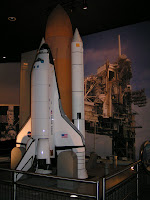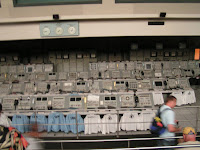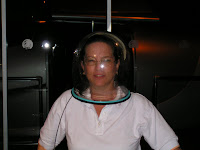While there we saw two 45 minute 3-D IMAX presentations, one featuring the International Space Station and the other showing footage of the 12 men who have walked on the moon. Both were highly entertaining, and the 3-D feature really made the trips come alive. We also spent some time at the Launch Status Center getting an update on the Space Station and tomorrow's Shuttle launch. The scale model replica of the the Shuttle and the Space Station hanging from the ceiling was very interesting.
time at the Launch Status Center getting an update on the Space Station and tomorrow's Shuttle launch. The scale model replica of the the Shuttle and the Space Station hanging from the ceiling was very interesting.
The VAB is one of the world's largest buildings (by volume) in third
Stop #2 brought us to the Apollo/Saturn V Center. As mentioned earlier, we had been here a few years back, and there have been many improvements and additions to this area. The tour of this building started with a re-creation of the launch of Apollo 11, the first manned mission to land on the moon. The original consoles, overhead screens, and audio of the launch countdown were incorp orated in this 15 minute theater presentation. The roaring of the engines as the Saturn V rocket lifts the astronauts into space creates not only a sense of excitement but of pride. During liftoff you could actually feel the windows behind you vibrating, and the glow of fire as Apollo lifts off the pad.
orated in this 15 minute theater presentation. The roaring of the engines as the Saturn V rocket lifts the astronauts into space creates not only a sense of excitement but of pride. During liftoff you could actually feel the windows behind you vibrating, and the glow of fire as Apollo lifts off the pad.
From there the theater dumps you out into a large expanse filled with all types of both life-size and scale model launch and orbiting vehicles as well as tributes to all the Apollo astronauts. Perhaps the highlight of this exhibit features an actual Sa turn V moon rocket. The Saturn V was the largest operational launch vehicle ever produced. Standing over 363 feet high with its Apollo Spacecraft payload and 33 feet in diameter, it produced over 7.5 million pounds of thrust at lift-off. Let's just say....it is big!! From there we entered another theater that re-lives the first moon landing by lunar module Eagle. Again, actual footage takes you through the final 60 seconds until touchdown and includes Neil Armstrong's first steps on the moon. It's hard to walk out of this building not being proud of the job done in realizing such an ambitious mission. The computer that flew in Apollo 11 has less memory than a cheap handheld calculator does today! Most of the calculations were done on slide rules and in the end when the Apollo splashed down in the ocean, it did so within 6 seconds of the mission plan. Truly amazing!
turn V moon rocket. The Saturn V was the largest operational launch vehicle ever produced. Standing over 363 feet high with its Apollo Spacecraft payload and 33 feet in diameter, it produced over 7.5 million pounds of thrust at lift-off. Let's just say....it is big!! From there we entered another theater that re-lives the first moon landing by lunar module Eagle. Again, actual footage takes you through the final 60 seconds until touchdown and includes Neil Armstrong's first steps on the moon. It's hard to walk out of this building not being proud of the job done in realizing such an ambitious mission. The computer that flew in Apollo 11 has less memory than a cheap handheld calculator does today! Most of the calculations were done on slide rules and in the end when the Apollo splashed down in the ocean, it did so within 6 seconds of the mission plan. Truly amazing!
Stop #3 was at the International Space Station Center. Since we had already been here for over 6 hours that day, we passed on this stop but understand that glass walls and ceilings allow you to view preparation of future Space Station payloads.
On Monday we headed back to the Kennedy Space Center touring the Rocket Garden, a grouping of the actual rockets used in past space launches. Here visitors can view the Redstone, Atlas and Titan rockets that first put NASA Astronauts in space, and in the Mercury, Gemini and Apollo capsules one can see firsthand just how cramped the quarters were for America's Astronaut pioneers. The nearby Astronaut Memorial contains a mirror monument to the astronauts who have been lost in the name of space exploration as well other plaques in recognition. We also visited a mock-up of the Shuttle Explorer.
From there we went to the Astronaut Hall of Fame located just outside the Kennedy Space Center, which houses the world's largest collection of personal astronaut memorabilia, particularly focusing on those astronauts who have been inducted into the Hall of Fame, as well as spacecraft. Among the Hall of Fame's displays are two spacecraft: Sigma 7, the Mercury spacecraft piloted by Wally Schirra which orbited the Earth six times in 1962, and CSM Kitty Hawk, the Command Module used in the Apollo 14 spaceflight to the moon. There are many hands-on  exhibits as well, which help one experience some of what the astronauts go through during training and flight. Russ tried out the Shuttle landing simulator but kept crashing. Guess he needs a lot more training!
exhibits as well, which help one experience some of what the astronauts go through during training and flight. Russ tried out the Shuttle landing simulator but kept crashing. Guess he needs a lot more training!

No comments:
Post a Comment